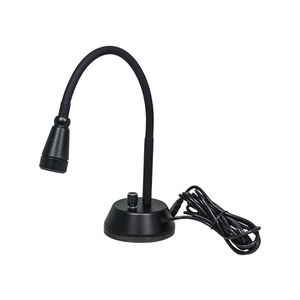Quick Overview
LED Light.
PM42012311 Penlight
Spot Light
| Light Source Type | LED Light |
| Battery | AAA |
| Applied Field | For PM4201 Series Portable Measurement Microscope |
Technical Info
Instructions
IlluminatorClose Λ
| The conditions of different illumination of the microscope are a very important parameter. Choosing the correct illumination method can improve the resolution and contrast of the image, which is very important for observing the imaging of different objects. The wavelength of the light source is the most important factor affecting the resolution of the microscope. The wavelength of the light source must be smaller than the distance between the two points to be observed in order to be distinguished by the human eye. The resolution of the microscope is inversely proportional to the wavelength of the light source. Within the range of the visible light, the violet wavelength is the shortest, providing also the highest resolution. The wavelength of visible light is between 380~780nm, the maximum multiple of optical magnification is 1000-2000X, and the limit resolution of optical microscope is about 200nms. In order to be able to observe a much smaller object and increase the resolution of the microscope, it is necessary to use light having a much shorter wavelength as the light source. The most commonly used technical parameters for describing illumination are luminescence intensity and color temperature. Luminescence intensity, with lumen as unit, is the physical unit of luminous flux. The more lumens, the stronger the illumination. Color temperature, with K (Kelvin) as unit, is a unit of measure indicating the color component of the light. The color temperature of red is the lowest, then orange, yellow, white, and blue, all gradually increased, with the color temperature of blue being the highest. The light color of the incandescent lamp is warm white, its color temperature is 2700K, the color temperature of the halogen lamp is about 3000K, and the color temperature of the daylight fluorescent lamp is 6000K. A complex and complete lighting system can include a light source, a lampshade or lamp compartment, a condenser lens, a diaphragm, a variety of wavelength filters, a heat sink cooling system, a power supply, and a dimming device etc. Select and use different parts as needed. Of which, selection and use of the illuminating light source is the most important part of the microscope illumination system, as and other components are designed around the illuminating wavelength curve and characteristics of the illuminating light source. Some of the microscope light sources are pre-installed on the body or frame of the microscope, and some are independent. There are many types and shapes of light sources. Depending on the requirements of the microscope and the object to be observed, one type or multiple types of illumination at the same time can be selected. In addition, the whole beam and band adjustment of the light source, the position and illumination angle of the light source, and the intensity and brightness of the light all have a great influence on the imaging. For microscope imaging, a good lighting system may be a system that allows for more freedom of adjustment. In actual work, such as industry, too many adjustment mechanisms may affect the efficiency of use, therefore choose the appropriated configured lighting conditions is very important. |
Spot LightClose Λ
| Spot light source of microscopic illumination, usually refers to the “spot” or dot shaped light source, converged at the light exits after the power source emits light. It is usually used for “oblique illumination”, and can be angled with the optical axis of the microscope, very suitable for illumination detecting the cracks, pipe walls etc. of some objects with “height and depth”. When focusing is required, a lens can be added in front of the spot light source for light concentration, making the illumination more uniform. The focal length of the spot light source usually falls directly on the focal plane of the lens/surface of the reflector in order to achieve maximum brightness and illumination effect. In spot light source, there is a kind of dual point light. In optical fiber illumination, it is called double pipe light guide, which can adjust the angle and brightness freely, so as to adjust the light and shadow of the illumination to reach the optimal position. There are also spot light source, which are split into multiple points of illumination on a ring to become a multi-point illumination source, it is a compromise between ring illumination and spot illumination. |













